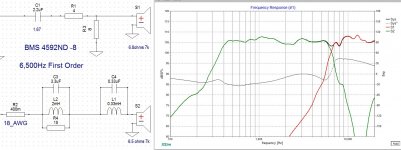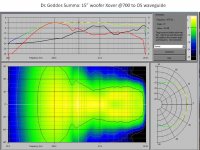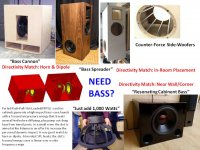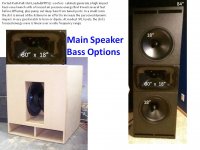Sound (!) advises. Even the "best" speaker may sound bad in a poorly designed room, while a more "modest" speaker may shine in comparison in a well designed room. And to aid the room designer, dispersion pattern of chosen (probable) speakers comes in as necessary for his work ... 

Even the "best" speaker may sound bad in a poorly designed room
One also has to consider what comes before the speakers as well.
dave
SBIR = Speaker Boundary Interference Response. https://www.google.se/search?q=spea...hUKEwjV3anaserOAhUKlSwKHcpuA0sQsAQIIw&dpr=1.5
Those deep 3 to 4 dips you usually see in the lower frequency response curve are due to reflections from nearby surfaces like wall, floor, ceiling. Higher up in frequency often from "stuff" between you and the speakers. EQ:ing will not change mode problems universally (for all seats), acoustic fixes inside the room work more for everyone inside it.
A good long educational thread on GS: https://www.gearslutz.com/board/studio-building-acoustics/584207-sbir.html
Those deep 3 to 4 dips you usually see in the lower frequency response curve are due to reflections from nearby surfaces like wall, floor, ceiling. Higher up in frequency often from "stuff" between you and the speakers. EQ:ing will not change mode problems universally (for all seats), acoustic fixes inside the room work more for everyone inside it.
A good long educational thread on GS: https://www.gearslutz.com/board/studio-building-acoustics/584207-sbir.html
Last edited:
For the BMS 4592ND-8, this 6,500Hz first order electrical circuit with minor compensation on the midrange simulates well and has good owner reviews in larger 2" horns.... like the Klipsch K-402Hi Face! Can your share your crossover?..
Attachments
SBIR = Speaker Boundary Interference Response.
Thanx. While that may not change, it has nothing to do with what i was talking about. That was more loss of information in the electronics before the speaker, which can be significant. If the speaker is cable of reproducing the missing information then the speaker is no longer the limiting component as far as this facet of reproduction goes.
dave
special attention may need to be given to the construction details of the surrounding walls
Particularly if mounting the speakers in said walls! I recently ran into a situation that even having the speakers mounted on or contacting the walls in a room caused a major coloration (the wall was picking up bass vibration... and these were old 'solid' plaster/lathe walls, too).
Well, as I see it; whatever is before the speaker can give a loss / addition of some measure. But ..., will it show up as some 15 to 30 dB difference between peaks and nulls in frequency response at LP? SBIR and room modes can and will, if they haven't been considered during acoustics planning of the room itself and those dB-differences cannot be fixed with something before the speaker. (No, I'm not arguing against you, more trying to put different things in perspective of importance, admitted, -from my perspective  )
)
 )
)Well, as I see it; whatever is before the speaker can give a loss / addition of some measure. But ..., will it show up as some 15 to 30 dB difference between peaks and nulls in frequency response at LP? SBIR and room modes can and will, if they haven't been considered during acoustics planning of the room itself and those dB-differences cannot be fixed with something before the speaker.
It is, but it is only an issue at low frequencies (as a generalization the larger the room, the lower the transition frequency but 100-300 Hz is common). The only way to deal with this is with the room (few thou are able to build a room from scratch -- i was
Much of the musical content (about ½ the energy is above 300 Hz) so information retention before the speakers is very important.
I have put modest speakers at the end of a really good front end, and i have put really good speakers on the end of a mediocre front end, and the system with the modest speakers invariably wins.
dave
ChopShop,
I have mains that consist of a Lambda Unity with a TD15X above and below, active. If you are sitting at any reasonable distance from them they will play louder (and still clean) than most people can bear. So I think you should go with the SH50/60 maybe with a sealed and EQ's TD18 below each and cross them higher than Danley says they can play to improve the LF. Then add subs.
If you have the $, I'd do it for all 7 speakers, but I don't think it's necessary to have all the same. It would be nice.
My surrounds were TD15S, TD10M, DE250+QSC WG. Because my room is small, I sat too close to the sides and they never integrated, even though there were 3 separate enclosure in each speaker angled so they focussed at the LP. They're being rebuilt with JBL 2225s and Faital Pro 8HX200 coaxes. I took a punt on these, so I hope they're as good in reality as they look on paper.
Subs are 4 FTW21s, 2 per enclosure, nearfield. The room is only 1800cf so they're more than enough.
I have mains that consist of a Lambda Unity with a TD15X above and below, active. If you are sitting at any reasonable distance from them they will play louder (and still clean) than most people can bear. So I think you should go with the SH50/60 maybe with a sealed and EQ's TD18 below each and cross them higher than Danley says they can play to improve the LF. Then add subs.
If you have the $, I'd do it for all 7 speakers, but I don't think it's necessary to have all the same. It would be nice.
My surrounds were TD15S, TD10M, DE250+QSC WG. Because my room is small, I sat too close to the sides and they never integrated, even though there were 3 separate enclosure in each speaker angled so they focussed at the LP. They're being rebuilt with JBL 2225s and Faital Pro 8HX200 coaxes. I took a punt on these, so I hope they're as good in reality as they look on paper.
Subs are 4 FTW21s, 2 per enclosure, nearfield. The room is only 1800cf so they're more than enough.
I have to tell you guys, the first time I heard the sh60s I knew the 50s would be the ticket. Then I heard the fifties and I thought there was just something different about the character. I have a friend who's had both so I've gotten to spend a good amount of time listening to them. They are fantastic speakers and do a lot really well. Something about their presentation just didn't suit me, which was really a drag cause I thought they'd make it really easy for me to just buy them and be done....
No argument from me there. If they don't knock you out, they just don't.
When I first lit mine up I thought they were a little soft on top. I gave myself a week to settle in and get to know them. I ended up putting a low Q two and a half dB push in them about 18kHz. A little delay and level tweeks to integrate them to the subs and I am pretty happy with them.
It is fun having several pretty decent different systems in house to compare one to another. It makes identifying and working out the issues easier.
Back to following along silently.
Barry.
Wow, thank you for all of the great response guys!
Lots to digest and give thought over here. As Face suggested the bms, td15 combo could get close to the fidelity of the tpl and td combo, and I still have waveguides, some 4594s, and some woofers, I may start by going back to that to see just how dialed in I can get them. Thanks Face for the encouragement! I had really all but written them off because I expected the first attempt at the active xover to be great (what a fool) and thought although they did some things great, they just werent' ever going to sound "right" to me. I don't think I gave them their due.
Lots to digest and give thought over here. As Face suggested the bms, td15 combo could get close to the fidelity of the tpl and td combo, and I still have waveguides, some 4594s, and some woofers, I may start by going back to that to see just how dialed in I can get them. Thanks Face for the encouragement! I had really all but written them off because I expected the first attempt at the active xover to be great (what a fool) and thought although they did some things great, they just werent' ever going to sound "right" to me. I don't think I gave them their due.
I still have waveguides, some 4594s, and some woofers, I may start by going back to that to see just how dialed in I can get them. I don't think I gave them their due.
AGREE: your best path today is to invest more engineering on a BMS 4594Nd + SEOS24 design down to 450Hz. You can experiment with passive crossovers similar to the 6,500Hz first order + compensation electrical circuits in post #66. Use active crossovers with more equalization complexity than simple BW or LR slopes provide.
Controlled Directivity
-------
Geddes and Toole favor designing speakers with a smooth Controlled Directivity function. Naturally narrow at 20kHz, constant to below 1kHz to avoid false reflection Binaural hearing queues, directivity smoothly widening down to a few hundred Hertz when natural 4-PI room effects dominate. The SEOS24 has 90H x 40V controlled directivity, plus a Baffle Step function starting at 400-500Hz which gradually widens to the 360 degree directivity function of a tall, 30" wide woofer box.
For a HT you cannot design for one perfect sound stage image, you design for 20 very good sound stage presentations.
Cannon Bass:
Ported and Sealed Push-Pull-Slot-Loaded(PPSL) woofers cabinets generate a high impact bass wave launch with a slot-focused air pressure energy that travels several feet before diffusing. In a modest depth room the slot is aimed at the listener in an effort to increase the perceived dynamic impact. A very good directivity match to horn or dipole mains. At modest SPL levels, the slot's focused energy wave is linear over a wide frequency range. This woofer design can improve the sound stage for a modest width of center HT seats.
Omni Bass:
Side-Side counter-force woofers in a sealed cabinet reduce vibration and start with a omni-directional launch when placed away-from-walls. For front speakers placed several feet away from the walls, this woofer design can improve blending HT front, side, and rear speakers.
-
Attachments
450Hz from a 24" horn mouth? Isn't that a bit ambitious?AGREE: your best path today is to invest more engineering on a BMS 4594Nd + SEOS24 design down to 450Hz.
Not at all. I wouldn't recommend it for this application, but others have used this combination down to 385hz.450Hz from a 24" horn mouth? Isn't that a bit ambitious?
Not at all. I wouldn't recommend it for this application, but others have used this combination down to 385hz.
Using that short little horn that low with a BMS driver is a sure way for unpleasant sound. If you want "jaw dropping" realistic low midrange use a full size, full space midbass horn with a cone driver.
A compromise I found to work well was a pair of stacked 90x40 500 Hz 1" throat horns [~190+ Hz cut-off IIRC] with the bottom one full range and the other low passed. This made for a slightly larger combined piston area than the 1.4" I wanted to replace and the stacked horn mouths gave me a larger, much more uniform polar pattern to a lower F than the 90x40 500 Hz multi-cell; all mainly to achieve the main goal of a much more extended HF, though ultimately dropped it to 350 Hz when higher order digital XOs and higher power handling diaphragms became available.
Considering the SPLs desired here though, the larger drivers + super tweeter horns is called for if a [2, 3 or 4] way Synergy concept [+ 'filler' mid-bass system if required] isn't an option, which is my preference/recommendation nowadays for any multi horn app, especially a 'no compromises' one.
GM
Considering the SPLs desired here though, the larger drivers + super tweeter horns is called for if a [2, 3 or 4] way Synergy concept [+ 'filler' mid-bass system if required] isn't an option, which is my preference/recommendation nowadays for any multi horn app, especially a 'no compromises' one.
GM
- Status
- This old topic is closed. If you want to reopen this topic, contact a moderator using the "Report Post" button.
- Home
- Loudspeakers
- Multi-Way
- No compromises home theater speaker build: advice needed




